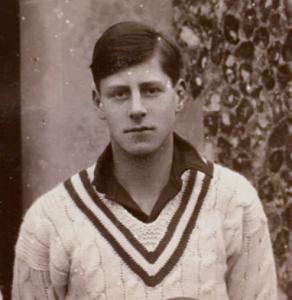
|

|
| Captain Paul Harry CROFTON-ATKINS (52553) | |
|
217 Battery, 112 (West Somerset Yeomanry) Field Regiment, Royal Artillery Date of birth: 23rd October 1911 Date of death: 10th July 1944 Killed in action aged 32 Buried at Banneville-La Campagne War Cemetery Plot VI Row F Grave 1 |

|
| Paul Harry Crofton-Atkins was born in London on the 23rd of October 1911 the younger son of Major-General Sir Alban Randell Crofton-Atkins, KCB, CMG, Royal Army Service Corps, and Lady May Clara (nee Bongard) Atkins MBE of "Ashcroft", Wembley Park in London. He was christened at the Church of St Mary the Virgin, Primrose Hill on the 16th of December 1911. He was educated at Lancing College where he was in Olds House from September 1925 to December 1929. He was a member of the Football XI in 1928 and 1929 and was a Sergeant in the Officer Training Corps achieving Certificate A in 1928. He gained his School Certificate in 1927. He was appointed as a House Captain and as a Prefect in 1929. In 1930 he passed into the Royal Military Academy at Woolwich from where he was commissioned as a 2nd Lieutenant in the Royal Engineers on the 27th of August 1931. His regiment landed at Normandy on D plus 21 as part of the Guards Armoured Division. They were first in action on the 29th of June 1944 at Pubot en Bassin and took part on later battles at Carpiquet Aerodrome and Caen. By the evening of the 9th of July 1944 the 24 guns of the West Somerset Yeomanry were positioned to take part in the battle for a German stronghold called Hill 112, just to the southwest of Caen, in an operation code named “Jupiter”. This position was described by the German General Erwin Rommel as the most important hill in Normandy. The infantry of 129 Brigade gathered at the start line for the attack with supporting armour in the form of Churchill and Sherman tanks. The British tanks were no match for the German Tiger tanks which had more powerful guns and thicker armour and which in most cases had been dug in. The advance began before dawn on the 10th of July and by 6.30am the leading units had taken their objectives and become engaged in fierce close quarter fighting with determined SS units which raged all day. Casualties were very high with the 43rd (Wessex) Division taking 2,000 casualties in the first 36 hours of the fighting. During the twelve days of the fight for Hill 112, the 112th Field Regiment fired some 65,000 shells from their 24 guns, an average of 225 a day, in support of the infantry and tank attacks on the hill. |
|
| Olds House |
Back